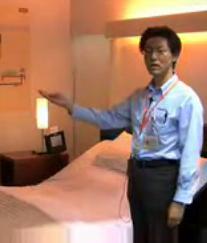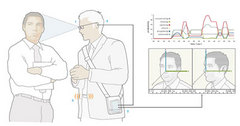Category: Health
Panasonic's Sleep Assist System
 This is the last thing modern society needs. We already have no problems whatsoever getting to sleep. Most of our problems in fact come from wanting to stay asleep, rather than doing productive work for the benefit of society.
This is the last thing modern society needs. We already have no problems whatsoever getting to sleep. Most of our problems in fact come from wanting to stay asleep, rather than doing productive work for the benefit of society.
'Fish on a chip' could save your life
New technology called ‘fluorescent in situ hybridization‘, or FISH, automates testing for chromosome mutations in a bunch of different types of cancer. This cuts test costs by 90% and speeds up the test process by a similar factor. It also means patients in rural areas don’t need to travel so much, because test kits can be administered under simpler settings. Finally, since it tests for a variety of cancers, it means quicker notice of the disease jumping from one organ to another, like a stealth evil Tarzan in the jungle of your intestines. “I believe that this might be the most important thing that any of us ever do,” said the University of Alberta professor Dr. Linda Pilarski. [GT]
‘Fish on a chip’ technology may speed cancer diagnosis
Related posts:
USB EarScope shows you what’s inside your ear, seriously
Emotional Social Intelligence Prosthetic camera tells you if you’re boring
Mice without Cdk5 brain enzyme are smarter
Fumakilla invites you to urinate on their message
Intended to improve aim as well as deliver targeted results, so to speak, Japanese bug spray Fumakilla has a new ad campaign being played out in men’s lavatories. They’ve put stickers of a fly in rifle crosshairs in the urinals. When whizzed on, the stickers, printed with a layer of heat-sensitive ink developed by Pilot Ink, change to show an advertising message. Fumakilla also has a website where you can practice in their Flash game (probably not that kind of flashing). [GT]
Heat-sensitive urinal stickers as bug spray marketing gimmick
Related posts
After a few beers, just what you need: talking urinals
Urinal, the videogame
Fragrant smelling urinals – they are taking the piss
USB EarScope shows you what's inside your ear, seriously
OK, Thanko, let’s get serious here. A Butt Cooler is strange enough, but a USB device that lets you look in your ear and then view the result on your computer? Yes, this might be a helpful tool for a doctor to see if you had an ear infection, but for home use, what good would it do you to study your own ear canal? (No, seriously, answers on a 3×5 card, please.) [GT]
USB EarScope (via Everything USB )
Related posts
Emotional Social Intelligence Prosthetic camera tells you if you’re boring
Colonic irrigation made easy with the self-guiding colonoscope
Sensear protects your ears and fills them with knowledge
Emotional Social Intelligence Prosthetic camera tells you if you're boring
We’ve all wandered off on tangents about our incredibly hilarious cat or intolerably handsome mate or unbelievably brilliant infant and usually manage to find our way back, but those with autism or Asperger’s Syndrome can easily stay socially lost. MIT grad student Rana El Kaliouby has developed a solution, an Emotional Social Intelligence Prosthetic which monitors the body language of those around you and relays you helpful hints like “stop talking about your collection of fat Elvis stamps”. The device correctly identified emotions 90% of the time when exposed to actors, and 64% of the time with everyday people, which is still probably more accurate than even healthy human beings. Damn, we’re self-absorbed. At least, I am. [GT]
Emotional Social Intelligence Prosthetic [via Popgadget]
Related posts
Electrosensitivity to electromagnetic radiation?
Biotex programme “intelligent textiles”
‘Caveman’ provides 4d rendering of the human body
Electrosensitivity to electromagnetic radiation?

The Guardian’s ‘Bad Science’ column looking sceptically at electrosensitivity has pulled an unusually high and polarized amount of comment: those who say electrosensitivity consistently manifests in the afflicted in a form like “mild radiation poisoning” related to immersion in Wi-Fi networks, mobile phone broadcast areas, unshielded microwaves, and other broadcast fields; and those who say that while electrosensitivity symptoms may or may not exist (Goldacre says they definitely do), the cause has not been appropriately/scientifically tied to high tech devices or fields. Whatever the origin of the symptoms turns out to be, Goldacre does expose some bad gadgets designed to exploit the ill. His medical opinion: don’t buy crap. [GT]
Watch out for that blob of radiation!
Related posts
Nanoparticle clothes to keep you healthy
Sensear protects your ears and fills them with knowledge
Spare your brain in morning and evening
Aoyama wool suit is as comfortable as a t-shirt

Japanese clothier Aoyama, the Japan Wool Textile Co., and two other companies have created a high-tech weave for a new kind of wool suit that breathes like a t-shirt. How did they manage that? The new process involves enlarging the spaces between the weave which allows six times as much air to pass through, as if through a conventional dress shirt. This should make the suit warm and cool at the same time. Advertisement, which involves flying jackets and a woman toting a thermometer, after the jump. [GT]
Aoyama breathable suit (Source in Japanese: Nikkei)
Related posts
Clothes with central heating
Biotex programme “intelligent textiles”
“Plastic” blood coming soon to a vein near you?
Biotex programme "intelligent textiles"

God knows we’re not very good at keeping track of our own health as a species, so it’s a good thing science is bringing us smart clothes that will keep an eye on how we’re doing physically. The Biotex programme “intelligent textiles” are designed for recovering hospital patients, people with chronic illnesses and injured athletes, to monitor sweat acidity, salinity and perspiration rate. By tracking metabolic changes the expectation is that infections and relapses will generally be easier to catch before they become severe. It is expected that future versions will have military applications, to allow mobile hospitals to track battlefield injuries. [GT]
Smart clothes to monitor health
Related posts
The Pentagon’s ‘Gay Bomb’
Mice without Cdk5 brain enzyme are smarter
“Plastic” blood coming soon to a vein near you?
The Pentagon's 'Gay Bomb'
The Pentagon brought new meaning to “don’t ask, don’t tell” with its undercover plans to develop a ‘Gay Bomb’ chemical weapon to, er, turn enemy soldiers gay so they’d start being, er, gay, on the battlefield, instead of fighting, as part of its exploration of non-lethal weapons development. “The Ohio Air Force lab proposed that a bomb be developed that contained a chemical that would cause enemy soliders to become gay, and to have their units break down because all their soldiers became irresistably attractive to one another,” said Edward Hammond, of Berkeley’s Sunshine Project. [GT]
Pentagon Confirms It Sought To Build A ‘Gay Bomb’ (via Metafilter)
Related posts
Weapon of Mass Destruction PC case is the bomb, baby
Danger Bomb Clock – break the wires to stop the explosion
The only gay in the toyshop
Mice without Cdk5 brain enzyme are smarter
UT Southwestern scientists built a better mouse brain by knocking out the Cdk5 brain enzyme. “Everything is more meaningful to these mice,” said the study’s senior author, Dr. James Bibb. “The increase in sensitivity to their surroundings seems to have made them smarter.” A new technique called “conditional knock out” allowed the team to actually remove the enzyme in adult mice, where previous methods required eliminating the entire gene. Developing. [GT]























